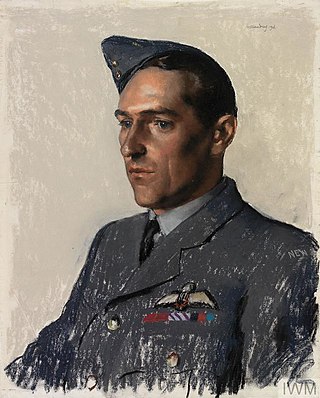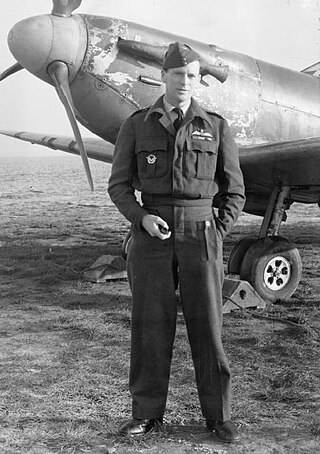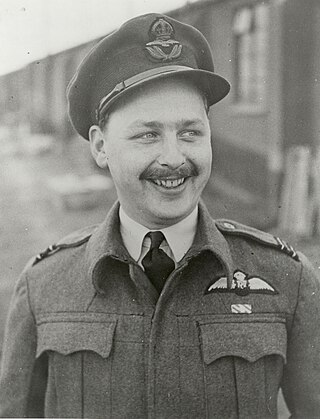
Group Captain Leonard Henry Trent, was a New Zealand aviator, senior Royal Air Force officer, and recipient of the Victoria Cross (VC), the highest award for gallantry in the face of the enemy that can be awarded to British and Commonwealth forces.
No. 118 Squadron was a squadron of the British Royal Air Force. Originally formed in 1918, it served as a fighter squadron in the Second World War, flying Spitfires and Mustangs. It flew jet fighters as part of RAF Germany in the 1950s, and Bristol Sycamore helicopters in Northern Ireland before finally disbanding in 1962.

The Battle of Britain Memorial Flight (BBMF) is a Royal Air Force flight which provides an aerial display group usually comprising an Avro Lancaster heavy bomber and two fighters, a Supermarine Spitfire and a Hawker Hurricane. The aircraft are regularly seen at events commemorating the Second World War and upon British State occasions, notably Trooping the Colour, celebrating Queen Elizabeth II's 80th birthday in 2006, and the wedding of Prince William and Catherine Middleton in 2011, and at air displays throughout the United Kingdom and Europe.

Wing Commander Lance Cleo "Wildcat" Wade DSO, DFC & Two Bars was an American pilot who joined the Royal Air Force (RAF) during the Second World War and became a flying ace. He remained with RAF until his death in a flying accident in 1944 in Italy. He was described as a "distinguished American fighter ace who epitomized perhaps more than any other American airman the wartime accords between Britain and the United States".

John Milne Checketts, was a New Zealand flying ace of the Second World War, who was credited with the destruction of 14+1⁄2 enemy aircraft, three probably destroyed and 11 damaged.

Air Commodore Alan Christopher Deere, was a New Zealand fighter ace with the Royal Air Force (RAF) during the Second World War. He was also known for several near-death experiences over the course of the war. This led to his published autobiography being titled Nine Lives.

Group Captain Colin Falkland Gray, was a Royal Air Force (RAF) officer and the top New Zealand fighter ace of the Second World War. He was credited with at least 27 aerial victories.

Raymond Brown Hesselyn, was a New Zealand fighter pilot and flying ace of the Second World War, credited with the destruction of at least 18 enemy aircraft while flying with the Royal Air Force (RAF) over Europe and the Mediterranean.

Brian Carbury, was a New Zealand fighter ace of the Royal Air Force (RAF) during the Second World War. He was officially credited with destroying 15+1⁄2 German aircraft.

The Supermarine Spitfire, the only British fighter to be manufactured before, during and after the Second World War, was designed as a short-range fighter capable of defending Britain from bomber attack and achieved legendary status fulfilling this role during the Battle of Britain. According to fighter ace J.E. "Johnnie" Johnson it was the best conventional defensive fighter of the war.
Air Vice-Marshal Ekanayake Edward Rohan Ameresekere, was a senior officer in the Royal Ceylon Air Force. He served as the third Commander of the Royal Ceylon Air Force. He previously served he had served as a navigator in the Royal Air Force during World War II, before qualifying as a pilot in the newly formed Royal Ceylon Air Force.

John Connell Freeborn, was a fighter pilot and flying ace in the Royal Air Force (RAF) during the Second World War.

Squadron Leader Mohinder Singh Pujji DFC, also known as Mahinder Singh Pujji, was a distinguished Royal Air Force fighter pilot and one of the first Indian Sikh pilots to volunteer with the Royal Air Force during the Second World War. He is one of the few Indian pilots to have also served in all three major theatres of the Second World War.
Michel G. L. "Mike" Donnet, was a Belgian pilot who served in the Belgian Army and British Royal Air Force (RAF) during the Second World War. He shot down four enemy aircraft confirmed, and achieved the RAF rank of wing commander. After the war, he returned to the Belgian Air Force, and held several important commands before retiring in 1975.
Air Commodore Sir Archibald Little Winskill, was a British Royal Air Force officer. He flew Spitfires in the Battle of Britain and evaded capture twice during the Second World War on two different continents. After the war, he held a number of appointment in different parts of the world. After retiring from the RAF, he became Captain of the Queen's Flight.

No. 485 (NZ) Squadron was a fighter squadron established for service during the Second World War. It was the first New Zealand squadron formed under Article XV of the Empire Air Training Plan. Although many of its flying personnel were largely drawn from the Royal New Zealand Air Force, the squadron served in Europe under the operational and administrative command of the Royal Air Force.

John Arthur Houlton was a New Zealand flying ace of the Royal New Zealand Air Force (RNZAF) during the Second World War. He was credited with the destruction of at least five German aircraft.
William Thomas Edward Rolls was a British flying ace of the Royal Air Force Volunteer Reserve (RAFVR) during the Second World War. He was credited with the destruction of at least 17 aircraft of the Axis powers.

Basil Gordon Collyns, was a New Zealand flying ace of the Royal New Zealand Air Force (RNZAF) during the Second World War. He is credited with at least five aerial victories.

Wilfred Sizer, was a British flying ace who served in the Royal Air Force (RAF) during the Second World War. He is credited with having shot down twelve aircraft.














